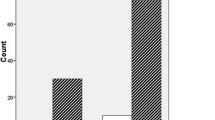Abstract
To examine the incidence of haemorrhage following tonsillectomy, to explore the usefulness of antibiotic in preventing postoperative haemorrhage and to examine if the haemorrhage depended on the level of expertise of the surgeon. A retrospective review analysing tonsillectomy method, the rate secondary haemorrhage, the grade of operating surgeon. A χ2 analysis was used to determine the statistical difference between the haemorrhage rates of different tonsillectomy methods. One thousand three hundred and thirty-six tonsillectomies were performed during this period by four different methods: 615 by cold steel dissection, 582 by Coblation, 32 by bipolar dissection and 107 by Helica thermal coagulation. 621 tonsillectomies were performed by Consultant grade and middle grades performed 693 operations. 124 patients (9.3 %) were readmitted with haemorrhage. The secondary haemorrhage requiring surgery for controlling bleeding for cold steel dissection method was 1.5 % compared to 6.7 % for coblation method (P < 0.01 %), 6.3 % for bipolar dissection and 1.9 % for Helica thermal coagulation method. Overall consultants had a post tonsillectomy haemorrhage rate of 5.5 % and middle grades had a rate of 3.7 %. 86.5 % of the patients were already on routine prophylactic oral antibiotics at the time of presentation with haemorrhage needing surgical arrest and 13.5 % were not on antibiotics (P < 0.05 %). There was statistically significant difference in secondary haemorrhage rate between coblation and cold steel dissection methods. Coblation tonsillectomies had an increased need for operative intervention to control secondary haemorrhage. Routine use of antibiotic and expertise of operating surgeon had no bearing on secondary haemorrhage rate.





Similar content being viewed by others
References
Younis RT, Lazar RH (2002) History and current practice of tonsillectomy. Laryngoscope 112:3–5
Martinez SA, Akin DP (1987) Laser tonsillectomy and adenoidectomy. Otolaryngol Clin North Am 20:371–376
Koltai PJ, Koltai CA, Mascha ET et al (2002) Intracapsular partial tonsillectomy for tonsillar hypertrophy in children. Laryngoscope 112(8):17–19
Andrea M (1993) Microsurgical bipolar cautery tonsillectomy. Laryngoscope 103:1177–1178
Weingarten C (1997) Ultrasonic tonsillectomy. Otolaryngol Head Neck Surg 116:193–196
Temple RH, Timms MS (2001) Paediatric coblation tonsillectomy. Int J Paediatr Otolaryngol 61:195–198
Timms MS, Temple RH (2002) Coblation Tonsillectomy: a double blind randomised controlled study. J Laryngol Otol 116:450–452
Chang KW (2005) Randomised controlled trail of coblation versus electro cautery. Otolaryngol Head Neck Surg 132:273–280
Sutton CJG (1995) Power sources in endoscopic surgery. Curr Opin Obstet Gynaecol 7:248–256
Nduka C, Super P, Monson J, Darzi A (1994) Cause and prevention of electrosurgical injuries in laparoscopy. J Am Coll Surg 179:161–170
Clark MPA, Smithard A, Jarvis P (2006) How we do it: coblation tonsillectomy complication rates from a single ENT department compared with the National Prospective Tonsillectomy Audit. Clin Otolaryngol 31:156–159
Belloso A, Timms MS (2003) Coblation tonsillectomy versus dissection tonsillectomy: postoperative haemorrhage. Laryngoscope 113:2010–2013
Amir J, Belloso A, Broomfield SJ, Morar P (2011) Return to theatre in secondary post-tonsillectomy haemorrhage: a comparison of coblation and dissection techniques. Eur Arch Otorhinolaryngol 268(6):807–816
Divi V, Benninger M (2005) Prospective tonsillectomy bleed: coblation versus non coblation. Laryngoscope 115:31–33
Windfuhr JP, Chen YS, Remmert S (2005) Haemorrhage following coblation tonsillectomy. Ann Otol Rhinol Laryngol 114:749–756
Javed F, Sadri M, Uddin J et al (2007) A complete audit cycle on post tonsillectomy haemorrhage. Acta Otolaryngol 127:300–304
Noon AP, Hargreaves S (2003) Increased post-operative haemorrhage seen in adult coblation tonsillectomy. J Laryngol Otol 117(9):704–706
Clinical Effectiveness Unit, Royal College, of Surgeons of England. National Prospective Tonsillectomy Audit. Report of an Audit in England and Northern Ireland between July 2003 and September 2004. Available at: http:/www.rcseng.ac.uk/services/publications/publications/pdf/ta-finalreport.pdf. Accessed 9 June 2011
Carney AS, Harris PK, MacFarlane PL, Nasser S, Esterman A (2008) The coblation tonsillectomy learning curve. Otolaryngol Head Neck Surg 138:149–152
O’Reilly BJ, Black S, Fernandes J, Panesar J (2003) Is the routine use of antibiotics justified in adult tonsillectomy? J Laryngol Otol 117(5):382–385
Lee WC, Duignan MC, Walsh RM, McRae-Moore JR (1996) An audit of prophylactic antibiotic treatment following tonsillectomy in children. J Laryngol Otol 110:357–359
Dhiwakar M, Clement WA, Supriya M, McKerrow WS (2010) Antibiotics to reduce post-tonsillectomy morbidity. Cochrane Database Syst Rev 7(7):CD005607
Author information
Authors and Affiliations
Corresponding author
Rights and permissions
About this article
Cite this article
Praveen, C.V., Parthiban, S. & Terry, R.M. High Incidence of Post-Tonsillectomy Secondary Haemorrhage Following Coblation Tonsillectomy. Indian J Otolaryngol Head Neck Surg 65, 24–28 (2013). https://doi.org/10.1007/s12070-012-0584-8
Received:
Accepted:
Published:
Issue Date:
DOI: https://doi.org/10.1007/s12070-012-0584-8




